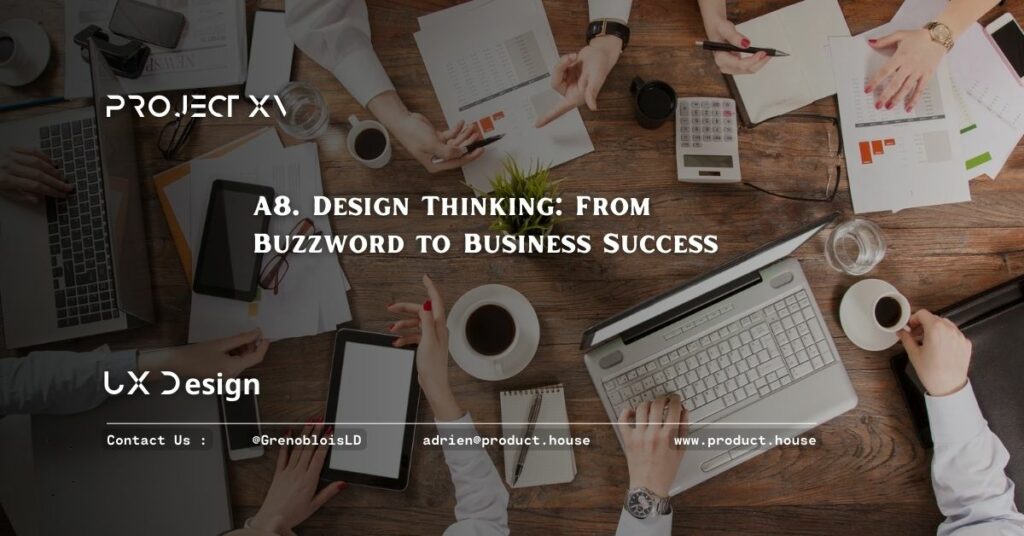A8. Design Thinking: From Buzzword to Business Success

Design Thinking: From Buzzword to Business Success
Are you tired of hearing the phrase “design thinking” thrown around in meetings and presentations? Are you wondering what it actually means and how it can benefit your business? Look no further. In this article, we’ll dive into the principles of design thinking and explore how it can drive business success.
What is Design Thinking?
Design thinking is an approach to problem-solving that involves empathizing with the user, defining the problem, ideating potential solutions, prototyping, and testing. It’s a human-centered approach to problem-solving that places the user’s needs at the center of the design process. Design thinking is not just for designers. It’s a methodology that can be applied to any business problem.
The Problem with Buzzwords
Let’s face it: the business world loves a good buzzword. It seems like every year there’s a new term that everyone is using. It’s not enough to just solve a problem. You have to “disrupt” the industry or “innovate” the solution. Design thinking is no exception. It’s become a buzzword that’s thrown around without a clear understanding of what it means or how it can benefit a business.
Why Design Thinking Matters
Design thinking matters because it puts the user at the center of the design process. By empathizing with the user and understanding their needs, businesses can create products and services that are more intuitive, usable, and enjoyable to use. Design thinking can also help businesses save time and money by identifying and solving problems early in the design process.
The Five Stages of Design Thinking
Design thinking is a five-stage process that involves empathizing with the user, defining the problem, ideating potential solutions, prototyping, and testing.
Empathize
The first stage of design thinking is to empathize with the user. This involves understanding the user’s needs, wants, and pain points. By putting yourself in the user’s shoes, you can gain insights into how they interact with your product or service. Empathy is a critical component of design thinking because it ensures that the solution is tailored to the user’s needs.
Define
The second stage of design thinking is to define the problem. This involves clearly articulating the problem that you’re trying to solve. Defining the problem is important because it ensures that you’re solving the right problem. By clearly articulating the problem, you can focus your efforts on finding a solution that will address the root cause of the problem.
Ideate
The third stage of design thinking is to ideate potential solutions. This involves generating a wide range of ideas, without judging them. The goal of ideation is to generate as many ideas as possible, even if they seem crazy or impractical. Ideation is important because it allows you to explore a wide range of solutions and find the best one.
Prototype
The fourth stage of design thinking is to prototype the solution. This involves creating a rough, low-fidelity version of the solution. Prototyping is important because it allows you to test the solution and identify any issues early in the design process. By prototyping, you can identify issues and make improvements before investing time and money into a fully-fledged solution.
Test
The fifth and final stage of design thinking is to test the solution. This involves testing the solution with users to ensure that it meets their needs. Testing is important because it ensures that the solution is usable and effective. By testing, you can gather feedback from users and make improvements to the solution before it’s released.
The Benefits of Design Thinking
Design thinking offers a range of benefits for businesses. Here are a few of the key benefits:
1. Customer-Centric Solutions
Design thinking ensures that solutions are tailored to the user’s needs. By empathizing with the user and understanding their needs, businesses can create solutions that are more intuitive, usable, and enjoyable to use.
2. More Efficient Processes
Design thinking can save businesses time and money by identifying and solving problems early in the design process. By prototyping and testing solutions, businesses can identify issues and make improvements before investing in a fully-fledged solution.
3. Competitive Advantage
Design thinking can give businesses a competitive advantage by enabling them to create innovative solutions that meet the needs of their customers. By focusing on the user’s needs, businesses can differentiate themselves from their competitors and win market share.
4. Improved Employee Engagement
Design thinking can improve employee engagement by giving employees a sense of ownership and purpose. By involving employees in the design process, they feel like their ideas and contributions are valued. This can lead to improved job satisfaction and productivity.
5. Increased Innovation
Design thinking can drive innovation by enabling businesses to explore a wide range of solutions and find the best one. By ideating a wide range of solutions, businesses can find innovative solutions to complex problems.
Design Thinking in Action
Let’s take a look at a real-world example of design thinking in action. Airbnb is a company that has embraced design thinking and used it to drive business success. When the founders of Airbnb started the company, they were having trouble finding affordable housing in San Francisco. They realized that other people were likely having the same problem, and they came up with the idea of renting out air mattresses in their living room to make some extra money.
The founders soon realized that the air mattress idea had potential to be a viable business. They used design thinking to refine the idea and create a platform that would enable people to rent out their homes to travelers. They empathized with the user and realized that travelers were looking for a more authentic experience than what was offered by traditional hotels. They defined the problem as the lack of affordable and authentic accommodations. They ideated a range of solutions, including the concept of renting out homes. They prototyped the solution by renting out their own apartment to travelers. And they tested the solution by launching the platform and gathering feedback from users.
Today, Airbnb is a multibillion-dollar company that has disrupted the hospitality industry. The founders of Airbnb used design thinking to create a solution that met the needs of their users and drove business success.
Conclusion
Design thinking is not just a buzzword. It’s a powerful methodology that can drive business success. By empathizing with the user, defining the problem, ideating potential solutions, prototyping, and testing, businesses can create solutions that are more intuitive, usable, and enjoyable to use. Design thinking can also save businesses time and money by identifying and solving problems early in the design process. So, the next time someone mentions “design thinking,” remember that it’s not just a buzzword. It’s a methodology that can drive business success.




